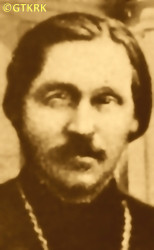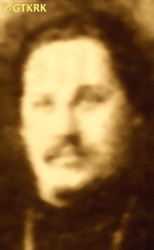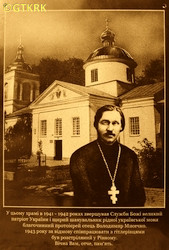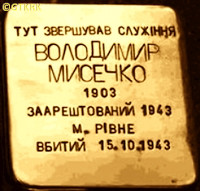Roman Catholic
St Sigismund parish
05-507 Słomczyn
85 Wiślana Str.
Konstancin deanery
Warsaw archdiocese, Poland
full list:
displayClick to display full list

searchClick to search full list by categories
wyświetlKliknij by wyświetlić pełną listę po polsku

szukajKliknij by przeszukać listę wg kategorii po polsku

Martyrology of the clergy — Poland
XX century (1914 – 1989)
personal data
surname
MYSIECZKO
forename(s)
Vladimir (pl. Włodzimierz)
function
presbiter (i.e. iereus)
creed
Eastern Orthodox Church ORmore on
en.wikipedia.org
[access: 2014.09.21]
diocese / province
„liberated lands of Ukraine” OR eparchy (Ukrainian Autocephalous Orthodox Church UOCP 1941‐1944)
Volyn OR eparchy (Polish Autocephalous Orthodox Church PAOC)more on
pl.wikipedia.org
[access: 2021.12.19]
date and place
of death
15.10.1943

Rivnetoday: Rivne urban hrom., Rivne rai., Rivne obl., Ukraine
more on
en.wikipedia.org
[access: 2021.09.17]
details of death
In 10.1943, during World War II, which began with the German and Russian attack on Poland in 09.1939, after the beginning of the German occupation as a result of the German attack on 22.06.1941 on their erstwhile ally, the Russians, when «Genocidium Atrox» was still taking place in Volyn — i.e. the genocide committed by Ukrainians against Poles, also known as „Volyn Genocide” — detained by the Germans on 16.07.1943.
Arrest prob. took place in Lutsk, where on that day the Germans detained c. 70 representatives of the local intelligentsia, including the closest associates of the head of the Ukrainian Autonomous Orthodox Church UAOC, Metropolitan Polikarp Sikorski. The reason for the detention — according to Ukrainian sources — were the activities of the Russian saboteur and partisan, Nikolai Kuznetsov, who carried out several successful terrorist attacks on German targets near Rivne. Perhaps, however, the real reason was the refusal to support German program of sending local people to work in Germany. However, it should be remember that a few days earlier, on 11.07.1943, the so‐called „Bloody Sunday”, the genocidal Ukrainian organization OUN/UPA carried out an attack on c. 99‐200 Polish settlements in Volyn, committing an unprecedented massacre of more then 11,000 Poles.
Held in prison in Rivne.
Tortured.
Finally taken with 33 other prisoners to a wilderness called Vydumka by the Ukrainians, just outside the city limits.
Murdered there.
cause of death
mass murder
perpetrators
Germans
sites and events
Rivne — 1943 murdersClick to display the description, Collective responsibility („Hostages”)Click to display the description, RivneClick to display the description, «Genocidium Atrox»Click to display the description, Ribbentrop‐MolotovClick to display the description
date and place
of birth
04.01.1903

Vovkoshivtoday: Hoshcha hrom., Rivne rai., Rivne obl., Ukraine
more on
uk.wikipedia.org
[access: 2024.01.26]
presbyter (holy orders)
ordination
04.09.1927

Pochaivtoday: Pochaiv urban hrom., Kremenets rai., Ternopil obl., Ukraine
more on
en.wikipedia.org
[access: 2020.09.27]
Dormition of the Mother of God OR churchmore on
en.wikipedia.org
[access: 2023.02.20] (Pochaiv Lavra)
positions held
1943
third presbiter (Eng. priest, i.e. iereus) — Rivnetoday: Rivne urban hrom., Rivne rai., Rivne obl., Ukraine
more on
en.wikipedia.org
[access: 2021.09.17] ⋄ Our Lord's Resurrection OR cathedral church
c. 1943
protoiereus (Eng. first priest) — Ukrainian Autocephalous Orthodox Church UAOC — dignity conferment
1943
presbiter (Eng. priest, i.e. iereus) — Lutsktoday: Lutsk city rai., Volyn obl., Ukraine
more on
en.wikipedia.org
[access: 2021.09.17] ⋄ Holy Trinity OR church
1941 – 1942
dean — Horokhivtoday: Horokhiv hrom., Lutsk rai., Volyn obl., Ukraine
more on
en.wikipedia.org
[access: 2020.11.27] OR deanery
1941 – 1942
parish priest — Horokhivtoday: Horokhiv hrom., Lutsk rai., Volyn obl., Ukraine
more on
en.wikipedia.org
[access: 2020.11.27] ⋄ Ascension of the Lord OR parish ⋄ Horokhivtoday: Horokhiv hrom., Lutsk rai., Volyn obl., Ukraine
more on
en.wikipedia.org
[access: 2020.11.27] OR deanery — after start of the German occupation and the expulsion from the parish of the predecessor — a „Russophile” — by the parishioners; also: translator of Old Slavic Church literature into Ukrainian and prefect of primary schools
25.02.1938
dean — Lokachitoday: Lokachi hrom., Volodymyr rai., Volyn obl., Ukraine
more on
en.wikipedia.org
[access: 2022.01.09] OR deanery — acting („ad interim”)
c. 09.07.1931
parish priest — Vuikovychitoday: Zaluzhne, Lokachi hrom., Volodymyr rai., Volyn obl., Ukraine
more on
uk.wikipedia.org
[access: 2024.01.26] ⋄ Ascension of the Lord OR parish ⋄ Lokachitoday: Lokachi hrom., Volodymyr rai., Volyn obl., Ukraine
more on
en.wikipedia.org
[access: 2022.01.09] OR deanery
c. 05.11.1928
parish priest — Parydubytoday: Smidyn hrom., Kovel rai., Volyn obl., Ukraine
more on
uk.wikipedia.org
[access: 2024.01.26] ⋄ St Nicholas OR parish ⋄ Kovel 1st distr.Orthodox deanery name
today: Kovel urban hrom., Kovel rai., Volyn obl., Ukraine
more on
en.wikipedia.org
[access: 2021.12.19] OR deanery
c. 17.07.1928
administrator — Zhabchetoday: Zhabche hrom., Lutsk rai., Volyn obl., Ukraine
more on
uk.wikipedia.org
[access: 2022.07.05] ⋄ St Peter and St Paul the Apostles OR parish — acting („ad interim”)
c. 27.06.1928
parish priest — Horodoktoday: Prylisne hrom., Kamin‐Kashyrskyi rai., Volyn obl., Ukraine
more on
uk.wikipedia.org
[access: 2024.01.26] ⋄ OR parish
c. 24.05.1928
parish priest — Olble Rusketoday: Hrudky, Kamin‐Kashyrskyi urban hrom., Kamin‐Kashyrskyi rai., Volyn obl., Ukraine
more on
uk.wikipedia.org
[access: 2024.01.26] ⋄ St Michael the Archangel OR parish
c. 1927 – 1928
rector — Lielikavatoday: Dyvin ssov., Kobryn dist., Brest reg., Belarus
more on
be.wikipedia.org
[access: 2024.01.26] ⋄ St Demetrius the Martyr OR church — appointment: on 25.08.1927
04.09.1927
presbiter (Eng. priest, i.e. iereus) — Pochaivtoday: Pochaiv urban hrom., Kremenets rai., Ternopil obl., Ukraine
more on
en.wikipedia.org
[access: 2020.09.27] ⋄ Polish Autocephalous Orthodox Church PACP ⋄ Dormition of the Mother of God OR monastery (Pochaiv Lavra) — priesthood cheirotonia, i.e. ordination
28.08.1927
deacon — Polish Autocephalous Orthodox Church PACP — diaconate cheirotonia, i.e. ordination
c. 1927
psalmist — Lielikavatoday: Dyvin ssov., Kobryn dist., Brest reg., Belarus
more on
be.wikipedia.org
[access: 2024.01.26] ⋄ St Demetrius the Martyr OR church — pastoral practices
c. 01.12.1925
psalmist — Novyi Oleksynetstoday: Lopushne hrom., Kremenets rai., Ternopil obl., Ukraine
more on
uk.wikipedia.org
[access: 2022.12.10] ⋄ Exaltation of the Holy Cross OR church — pastoral practices
c. 27.11.1924
psalmist — Datyntoday: Velymche hrom., Kovel rai., Volyn obl., Ukraine
more on
uk.wikipedia.org
[access: 2024.01.26] ⋄ Exaltation of the Holy Cross OR parish — pastoral practices
c. 23.09.1924
psalmist — Uizdtsitoday: Zdovbytsya hrom., Rivne rai., Rivne obl., Ukraine
more on
uk.wikipedia.org
[access: 2024.01.26] ⋄ Intercession of the Blessed Virgin Mary OR church — pastoral practices
c. 16.08.1924
psalmist — Yaynotoday: Pishchane, Kamin‐Kashyrskyi urban hrom., Kamin‐Kashyrskyi rai., Volyn obl., Ukraine
more on
uk.wikipedia.org
[access: 2024.01.26] ⋄ Intercession of the Blessed Virgin Mary OR church — pastoral practices
c. 08.11.1923
psalmist — Pyryatyntoday: Pevcha hrom., Dubno rai., Rivne obl., Ukraine
more on
uk.wikipedia.org
[access: 2024.01.26] ⋄ St Michael OR church — pastoral practices
1922 – c. 1927
student — Kremenetstoday: Kremenets urban hrom., Kremenets rai., Ternopil obl., Ukraine
more on
en.wikipedia.org
[access: 2020.10.18] ⋄ philosophy and theology, Orthodox Theological Seminary
married — at least one daughter
others related
in death
MAŁUŻYŃSKIClick to display biography Nicholas, PEREBYJNOSClick to display biography Vladimir
sites and events
descriptions
Rivne — 1943 murders: On 15.10.1943 and 19.11.1943 the Germans executed all prisoners held in prisons in Rivne. Sources estimate the number of victims — considered hostages by the Germans — to be between 350 and 3,000. There were at least 5 Orthodox priests among them. They were all shot, burned and buried just outside the city, on the Vydumky route. The murders were a reaction to the activities of the Russian raider, spy, saboteur and partisan, Nikolai Kuznetsov, who carried out several extremely bold and successful terrorist attacks near Rivne on the targets of the Germ. Reichskommissariat Ukraine, including on 20.09.1943 on Gen. Hans Gehl and Major Adolf Winter, 10.10.1943 on Gen. Herman Knuth, 15.11.1943 on Gen. Maj. Max Ilgen, 16.11.1943 on SA‐Oberführer Alfred Funk. Mass murders also took place in other cities of Volyn and Polesie — in Dubna, Lutsk, Sarny. (more on: rvnews.rv.uaClick to attempt to display webpage
[access: 2024.01.26])
Collective responsibility („Hostages”): A criminal practice implemented by the Germans in the occupied territories of Poland, applied from the very first day of World War II. At its core was an appointment and public announcement of a list of names of selected people whose lives depended on absolute compliance with German orders. Any violation of these ordinances, by any person, regardless of the circumstances, resulted in the murder of the designated „hostages”. In the first days of the war and occupation, it was used i.a. by the German Wehrmacht army to prevent acts of continuation of the defense by the Poles. Later, especially in the German‐run General Governorate, it was part of the official policy of the occupation authorities — collective responsibility for any acts of resistance to the occupier's practices. For the life of one German, even if death was due to customary reasons, the Germans carried out executions from a dozen to even a hundred Poles previously designated as „hostages”.
Rivne: During the German occupation (1941‐1944), there were two POW camps (mainly for Russian POWs) and two prisons (including the so‐called district prison at 16 Soborna Street) in Rivne, Ukraine. Several tens of thousands of Volyn intellectuals, peasants and workers, mainly Ukrainians and Poles, were imprisoned there, including thousands of resistance fighters of various nationalities, political and religious views and social status. Only a few managed to survive. Most of them, after torture, were shot and buried in mass graves, including: at Bila Street, in the Sosonky and Vydumky wilderness near Rivne (the latter today within the city limits), near the villages of Shubkiv (c. 20 km from the city) and Shpaniv (c. 5 km from Rivne), in the Grabnyk and Dubensky cemeteries, and in prison areas. (more on: rvnews.rv.uaClick to attempt to display webpage
[access: 2024.01.26])
«Genocidium Atrox»: In 1939‐1947, especially in 1943‐1944, independent Ukrainian units, mainly belonging to genocidal Ukrainian organizations OUN (political arm) and UPA (military arm), supported by local Ukrainian population, murdered — often in extremely brutal way — in Volyn and surrounding regions of pre‐war Poland, from 130,000 to 180,000 Poles, all civilians: men, women, children, old and young. Polish‐Ukrainian conflict that openly emerged during and after World War I (in particular resulting in Polish‐Ukrainian war of 1918‐1919), that survived and even deepened later when western Ukraine became a part Poland, exploded again after the outbreak of the World War II in 09.1939. During Russian occupation of 1939‐1941, when hundreds of thousands of Poles were deported into central Russia, when tens of thousands were murdered (during so‐called Katyń massacres, among others), this open conflict had a limited character, helped by the fact that at that time Ukrainians, Ukrainian nationalists in particular, were also persecuted by the Russians. The worst came after German‐Russian war started on 22.06.1941 and German occupation resulted. Initially Ukrainians supported Germans (Ukrainian police was initiated, Ukrainians co—participated in extermination of the Jews and were joining army units fighting alongside Germans). Later when German ambivalent position towards Ukraine became apparent Ukrainians started acting independently. And in 1943 one of the units of aforementioned Ukrainian OUN/UPA organization, in Volyn, started and perpetrated a genocide of Polish population of this region. In mere few weeks OUN/UPA murdered, with Germans passively watching on the sidelines, more than 40,000 Poles. This strategy was consequently approved and adopted by all OUN/UPA organisations and similar genocides took place in Eastern Lesser Poland (part of Ukraine) where more than 20,000 Poles were slaughtered, meeting however with growing resistance from Polish population. Further west, in Chełm, Rzeszów, etc. regions this genocide turned into an extremely bloody conflict. In general genocide, perpetrated by Ukrainian nationalists, partly collaborating with German occupants, on vulnerable Polish population took part in hundreds of villages and small towns, where virtually all Polish inhabitants were wiped out. More than 200 priests, religious and nuns perished in this holocaust — known as «Genocidium Atrox» (Eng. „savage genocide”) The nature and purpose of genocide is perhaps best reflected in the song sung by the murderers: „We will slaughter the Poles, we will cut down the Jews, we must conquer the great Ukraine” (ukr. „Поляків виріжем, Євреїв видусим, велику Україну здобути мусим”). This holocaust and conflict ended up in total elimination of Polish population and Polish culture from Ukraine, in enforced deportations in 1944‐1945 of remaining Poles from Ukraine and some Ukrainians into Ukraine proper, and finally in deportation of Ukrainians from East‐South to the Western parts of Polish republic prl by Commie‐Nazi Russian controlled Polish security forces („Vistula Action”). (more on: www.swzygmunt.knc.plClick to attempt to display webpage
[access: 2021.06.20])
Ribbentrop‐Molotov: Genocidal Russian‐German alliance pact between Russian leader Joseph Stalin and German leader Adolf Hitler signed on 23.08.1939 in Moscow by respective foreign ministers, Mr. Vyacheslav Molotov for Russia and Joachim von Ribbentrop for Germany. The pact sanctioned and was the direct cause of joint Russian and German invasion of Poland and the outbreak of the World War II in 09.1939. In a political sense, the pact was an attempt to restore the status quo ante before 1914, with one exception, namely the „commercial” exchange of the so‐called „Kingdom of Poland”, which in 1914 was part of the Russian Empire, fore Eastern Galicia (today's western Ukraine), in 1914 belonging to the Austro‐Hungarian Empire. Galicia, including Lviv, was to be taken over by the Russians, the „Kingdom of Poland” — under the name of the General Governorate — Germany. The resultant „war was one of the greatest calamities and dramas of humanity in history, for two atheistic and anti‐Christian ideologies — national and international socialism — rejected God and His fifth Decalogue commandment: Thou shall not kill!” (Abp Stanislav Gądecki, 01.09.2019). The decisions taken — backed up by the betrayal of the formal allies of Poland, France and Germany, which on 12.09.1939, at a joint conference in Abbeville, decided not to provide aid to attacked Poland and not to take military action against Germany (a clear breach of treaty obligations with Poland) — were on 28.09.1939 slightly altered and made more precise when a treaty on „German‐Russian boundaries and friendship” was agreed by the same murderous signatories. One of its findings was establishment of spheres of influence in Central and Eastern Europe and in consequence IV partition of Poland. In one of its secret annexes agreed, that: „the Signatories will not tolerate on its respective territories any Polish propaganda that affects the territory of the other Side. On their respective territories they will suppress all such propaganda and inform each other of the measures taken to accomplish it”. The agreements resulted in a series of meeting between two genocidal organization representing both sides — German Gestapo and Russian NKVD when coordination of efforts to exterminate Polish intelligentsia and Polish leading classes (in Germany called «Intelligenzaktion», in Russia took the form of Katyń massacres) where discussed. Resulted in deaths of hundreds of thousands of Polish intelligentsia, including thousands of priests presented here, and tens of millions of ordinary people,. The results of this Russian‐German pact lasted till 1989 and are still in evidence even today. (more on: en.wikipedia.orgClick to attempt to display webpage
[access: 2015.09.30])
sources
personal:
www.volyn.com.uaClick to attempt to display webpage
[access: 2024.01.26], www.volynnews.comClick to attempt to display webpage
[access: 2024.01.26], esu.com.uaClick to attempt to display webpage
[access: 2024.01.26]
bibliographical:
„Hierachy, clergy and employees of the Orthodox Church in the 19th‐21st centuries within the borders of the Second Polish Republic and post–war Poland”, Fr Gregory Sosna, M. Antonine Troc-Sosna, Warsaw–Bielsk Podlaski 2017
original images:
www.volyn.com.uaClick to attempt to display webpage
[access: 2024.01.26], www.volynnews.comClick to attempt to display webpage
[access: 2024.01.26], www.volynnews.comClick to attempt to display webpage
[access: 2024.01.26], www.volynnews.comClick to attempt to display webpage
[access: 2024.01.26], www.volynnews.comClick to attempt to display webpage
[access: 2024.01.26], retrorivne.com.uaClick to attempt to display webpage
[access: 2024.01.26]
LETTER to CUSTODIAN/ADMINISTRATOR
If you have an Email client on your communicator/computer — such as Mozilla Thunderbird, Windows Mail or Microsoft Outlook, described at WikipediaPatrz:
en.wikipedia.org, among others — try the link below, please:
LETTER to CUSTODIAN/ADMINISTRATORClick and try to call your own Email client
If however you do not run such a client or the above link is not active please send an email to the Custodian/Administrator using your account — in your customary email/correspondence engine — at the following address:

giving the following as the subject:
MARTYROLOGY: MYSIECZKO Vladimir
To return to the biography press below:
 Click to return to biography
Click to return to biography













